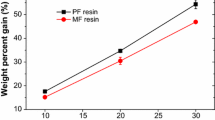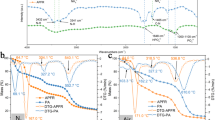Abstract
Poplar (Populus adenopoda Maxim.) and radiata pine (Pinus radiata Don.) wood were treated with an aqueous solution containing styrene-acrylic copolymer (SAC) and sodium silicate (SS). The effects of this treatment on the thermal stability and combustion behavior of the wood were determined. Thermogravimetric (TG) analysis showed that treatment in the presence of SS resulted in earlier thermal degradation compared to samples untreated and treated with SAC alone. Cone calorimetry showed that treatment of wood with SAC alone resulted in increased total heat release, total smoke production, and CO and CO2 concentration. Wood treated with SAC/SS was more difficult to ignite as evidenced by longer ignition time and higher limiting oxygen index; however, the treatment did not reduce the production of smoke and carbon oxide. Scanning electron microscopy and energy dispersive X-ray analysis of residual char indicated that SS was mainly deposited in the lumina of vessel or tracheid, and SS distribution in wood was not uniform. These findings demonstrate that incorporation of SS retards the flame of SAC-treated wood; however, the fire risk is not reduced due to dense smoke and CO production.











Similar content being viewed by others
References
Böttcher H, Jagota C, Trepte J, Kallies K-H, Haufe H (1999) Sol–gel composite films with controlled release of biocides. J Control Release 60(1):57–65
Browne FL (1958) Theories of the combustion of wood and its control. Dept. of Agriculture, Forest Service, Forest Products Laboratory, Madison
Che W, Xiao Z, Han G, Zheng Z, Xie Y (2018) Radiata pine wood treatment with a dispersion of aqueous styrene/acrylic acid copolymer. Holzforschung 72(5):387–397
Chuang C-S, Tsai K-C, Wang M-K, Ko C-H, Ing-Luen S (2009) Impact of the intumescent formulation of styrene acrylic-based coatings on the fire performance of thin painted red lauan (Parashorea spp.) plywood. Eur J Wood Prod 67(4):407–415
De Vetter L, Cnudde V, Masschaele B, Jacobs P, Van Acker J (2006) Detection and distribution analysis of organosilicon compounds in wood by means of SEM-EDX and micro-CT. Mater Charact 56(1):39–48
Donath S, Militz H, Mai C (2004) Wood modification with alkoxysilanes. Wood Sci Technol 38(7):555–566
Donath S, Militz H, Mai C (2006) Creating water-repellent effects on wood by treatment with silanes. Holzforschung 60(1):40–46
Dong Y, Yan Y, Zhang S, Li J, Wang J (2015) Flammability and physical–mechanical properties assessment of wood treated with furfuryl alcohol and nano-SiO2. Eur J Wood Prod 73(4):457–464
Fan F, Xia Z, Li Q, Li Z, Chen H (2013) Thermal stability of phosphorus-containing styrene–acrylic copolymer and its fire retardant performance in waterborne intumescent coatings. J Therm Anal Calorim 114(3):937–946
Furuno T, Uehara T, Jodai S (1991) Combination of wood and silicate I-Impregnation by water glass and application of aluminium sulfate and calcium chloride as reactants. Mokuzai Gakkaishi 37(5):462–472
Furuno T, Shimada K, Uehara T, Jodai S (1992) Combination of wood and silicate, 2: Wood-mineral composites using water glass and reactants of barium chloride, boric acid, and borax, and their properties. Mokuzai Gakkaishi 38(5):448–457
Furuno T, Uehara T, Jodai S (1993) Combinations of wood and silicate, 3: some properties of wood-mineral composites using the water glass-boron compound system. Mokuzai Gakkaishi 39(5):561–570
Gao M, Li S, Sun C (2004) Thermal degradation of wood in air and nitrogen treated with basic nitrogen compounds and phosphoric acid. Combust Sci Technol 176(12):2057–2070
Giudice CA, Pereyra AM (2007) Fire resistance of wood impregnated with soluble alkaline silicates. Adv Mater Sci Eng 2007:1–4
Grekin M (2006) Nordic scots pine vs. selected competing species and non-wood substitute materials in mechanical wood products: literature survey. Finnish Forest Research Institute, Helsinki
Harada T (2001) Time to ignition, heat release rate and fire endurance time of wood in cone calorimeter test. Fire Mater 25(4):161–167
Hazarika A, Maji TK (2014) Properties of softwood polymer composites impregnated with nanoparticles and melamine formaldehyde furfuryl alcohol copolymer. Polym Eng Sci 54(5):1019–1029
Hill CA (2007) Wood modification: chemical, thermal and other processes. vol 5. John Wiley & Sons, West Sussex
Hirata T, Kawamoto S, Nishimoto T (1991) Thermogravimetry of wood treated with water-insoluble retardants and a proposal for development of fire-retardant wood materials. Fire Mater 15(1):27–36
Hirschler M (1992) Heat release from plastic materials. In: Heat release in fires. Elsevier, London, pp 375–422
Hurt RH, Calo JM (2001) Semi-global intrinsic kinetics for char combustion modeling. Combust Flame 125(3):1138–1149
ISO 5660-1 (2002) Reaction-to-fire tests—heat release, smoke production and mass loss rate—Part 1: heat release rate (cone calorimeter method); ISO International Organization for Standardization
Jiang T, Feng X, Wang Q, Xiao Z, Wang F, Xie Y (2014) Fire performance of oak wood modified with N-methylol resin and methylolated guanylurea phosphate/boric acid-based fire retardant. Constr Build Mater 72(2014):1–6
Mahltig B, Swaboda C, Roessler A, Böttcher H (2008) Functionalising wood by nanosol application. J Mater Chem 18(27):3180–3192
Mahr MS, Hübert T, Schartel B, Bahr H, Sabel M, Militz H (2012) Fire retardancy effects in single and double layered sol–gel derived TiO2 and SiO2-wood composites. J Sol-Gel Sci Technol 64(2):452–464
Mai C, Militz H (2004) Modification of wood with silicon compounds. Treatment systems based on organic silicon compounds—a review. Wood Sci Technol 37(6):453–461
Marney D, Russell L, Mann R (2008) Fire performance of wood (Pinus radiata) treated with fire retardants and a wood preservative. Fire Mater 32(6):357–370
Miyashita H, Ohmi M, Tominaga H, Sawatari A, Suzuki M, Kawarada K, Mizumoto K (2000) The distribution of silicon atoms in sugi wood treated with gamma-methacryloxypropyl trimethoxysilane and its fire retardancy. Mokuzai Gakkaishi 46(5):449–455
Nagaoka T, Kodaira A, Uehara S (1988) Relationship between density and the ignitability and combustibility of wood. Fire Saf Sci 3:197–208
Peng Y, Han Y, Gardner DJ (2012) Southern pine impregnated with silicate solution containing cellulose nanofibrils. Holzforschung 66(6):735–737
Pereyra AM, Giudice CA (2009) Flame-retardant impregnants for woods based on alkaline silicates. Fire Saf J 44(4):497–503
Pries M, Mai C (2013) Treatment of wood with silica sols against attack by wood-decaying fungi and blue stain. Holzforschung 67(6):697–705
Qu H, Wu W, Wu H, Xie J, Xu J (2010) Study on the effects of flame retardants on the thermal decomposition of wood by TG–MS. J Therm Anal Calorim 103(3):935–942
Rochow EG (2013) The chemistry of silicon: Pergamon International Library of Science, Technology, Engineering and Social Studies vol 9. Elsevier, US
Schartel B, Hull TR (2007) Development of fire-retarded materials—interpretation of cone calorimeter data. Fire Mater 31(5):327–354
Šimkovic I, Martvon̆ová H, Maníková D, Grexa O (2005) Flame retardance of insolubilized silica inside of wood material. J Appl Polym Sci 97(5):1948–1952
Slimak KM, Slimak RA (2007) Process of using sodium silicate to create fire retardant products. US6303234B1. Google Patents, Granted Patent
Spearpoint M, Quintiere J (2000) Predicting the burning of wood using an integral model. Combust Flame 123(3):308–325
Tanno F, Saka S, Yamamoto A, Takabe K (1998) Antimicrobial TMSAH-added wood-inorganic composites prepared by the sol–gel process. Holzforschung 52(4):365–370
Tilak G (1985) Thermosetting acrylic resins-a literature review. Prog Org Coat 13(5):333–345
Wang J, Zhang M, Chen M, Min F, Zhang S, Ren Z, Yan Y (2006) Catalytic effects of six inorganic compounds on pyrolysis of three kinds of biomass. Thermochim Acta 444(1):110–114
Wang F, Liu J, Lv W (2017) Thermal degradation and fire performance of wood treated with PMUF resin and boron compounds. Fire Mater 41(8):1051–1057
Winnik MA (2002) Interdiffusion and crosslinking in thermoset latex films. J Coat Technol 74(925):49–63
Xiao Z, Xu J, Mai C, Militz H, Wang Q, Xie Y (2016) Combustion behavior of Scots pine (Pinus sylvestris L.) sapwood treated with a dispersion of aluminum oxychloride-modified silica. Holzforschung 70(12):1165–1173
Xie Y, Xu J, Militz H, Wang F, Wang Q, Mai C, Xiao Z (2016) Thermo-oxidative decomposition and combustion behavior of Scots pine (Pinus sylvestris L.) sapwood modified with phenol-and melamine-formaldehyde resins. Wood Sci Technol 50(6):1125–1143
Yan Y, Dong Y, Li J, Zhang S, Xia C, Shi SQ, Cai L (2015) Enhancement of mechanical and thermal properties of Poplar through the treatment of glyoxal-urea/nano-SiO2. RSC Adv 5(67):54148–54155
Yu X, Sun D, Li X (2011) Preparation and characterization of urea-formaldehyde resin-sodium montmorillonite intercalation-modified poplar. J Wood Sci 57(6):501–506
Zhong Z, Yu Q, Yao H, Wu W, Feng W, Yu L, Xu Z (2013) Study of the styrene–acrylic emulsion modified by hydroxyl-phosphate ester and its stoving varnish. Prog Org Coat 76(5):858–862
Acknowledgements
This work was supported by the National Key Research and Development Program of China (2017YFD0600203), the National Natural Science Foundation of China (31470585 & 31500469), and the Natural Science Foundation of Heilongjiang Province, China (JC2015006).
Author information
Authors and Affiliations
Corresponding authors
Additional information
Publisher’s Note
Springer Nature remains neutral with regard to jurisdictional claims in published maps and institutional affiliations.
Rights and permissions
About this article
Cite this article
Nguyen, T.T., Nguyen, T.V.K., Xiao, Z. et al. Combustion behavior of poplar (Populus adenopoda Maxim.) and radiata pine (Pinus radiata Don.) treated with a combination of styrene-acrylic copolymer and sodium silicate. Eur. J. Wood Prod. 77, 439–452 (2019). https://doi.org/10.1007/s00107-019-01401-2
Received:
Published:
Issue Date:
DOI: https://doi.org/10.1007/s00107-019-01401-2




